How to Draw Curves |
||||||||||||||||
|
Page 11 / 25
 CHAPTER X HOW TO DRAW CURVES BY STRAIGHT LINESWE will now consider curves in another way. Look at Illus. XXXV and XXXVI. The former shows how the curves of the bridge and railing would look ; the latter the curves of a causeway. 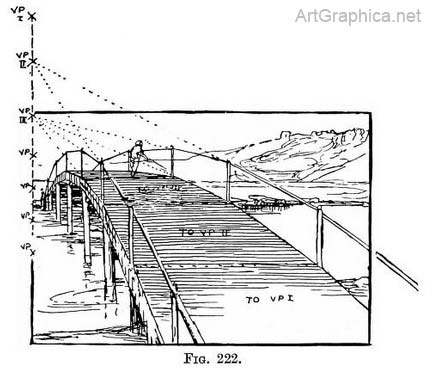
Perspective of a head. — I hesitate before applying hard and fast rules to the drawing of those exquisite curves, seen on the human figure. To attempt to describe how perspective steps in would but end in a boring wordiness. But I insist that the curves and contours will be better understood, and so better rendered, by the train of thought that follows a knowledge of perspective. For example, we know that it is less difficult to place the features on a head correctly if we sketch them as lying on lines encircling from side to side. The tilt of the head upwards or downwards will be expressed by the fullness of curves made by these lines—we think of them as parts of circles seen from below, or from above, respectively. It is easy to understand then that if the length of the nose and the ears lie between two such parallel lines, their position in regard to one another is automatically regulated in many positions of the head by the curvature of those lines. Another line taken up the face from the centre of the chin to the central parting of the hair becomes, in any other view except that of a full face, a part of a circular line seen from one side, and consequently denotes the foreshortening of the head and face (Figs. 224-226, Illus. XXXVII et seq.).
Contours on a figure. — In a foreshortened view of a limb or the trunk, the contours that overlap or even hide the forms behind them are often more valuable for expressing the action and structure of the figure than the outline itself. The nicety of these foreshortened curves will not be overlooked if we how the appearance of a circle in any position. Contours on animals. — There is a nicety in the line of a foreshortened circle, whether it is on a figure, a cloud, or an animal, that is so expressive and yet elusive. It may be missed from not being recognised as just the line that would show which way a form is tilted. It is good sometimes to draw forms without a model, so that each plane has to be thought of and then built up to another. 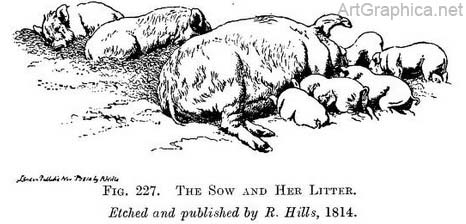
The habit breaks one of making unintelligent copies, and quickens one's wits in detecting a useful line. In Hills' etching (Fig. 227) every line has its use. The circle of a Sower. — In the majority of flowers the circle is the basis for their design (Figs. 228, 229, 230). In some it may do service not as an actual circle, but to set a boundary for each petal. 
In others, it has a lavish use — pistil, stamens, petals, and sepals all regulated by concentric circles ; each part radiating from the centre of its circle ; the whole beautiful in its symmetry, varied repetition, and exactness. The plant itself displays each floret bravely. Circles in full-face, circles nodding, tilted sideways, upwards and down, this way and that. All the facts we studied in cart-wheels and pots and pans, are in every flower a commonplace beauty ready for our appreciation. In foliage. — Leaves of certain trees and shrubs are nearly circular in outline. The hazel, apple, alder, and some leaves of the aspen may be cited. Their foliage studied at close quarters displays the infinite variety in the forms of a circle when seen in different positions. The poplar holds its leaves well apart, each with its individual tilt, so that we cannot overlook the charm of line in a foreshortened circle. The great leaves of the burdock have often figured in the landscape painter's foreground, and its appioximate circle been made good use of in the composition. The circular leaves of celandine, buttercup, marsh marigold, and some ivies, and many others of oval form, however slightly indicated, might be given their true character if the circle and its ways are understood. Water-lily leaves give flatness to the surface of the water. They float, pointing this way and that—almost appearing as a true circle by your boat-side ; reduced to the thickness of a line in the distance (Illus. XL).
Layers of foliage (notice it on the beech and hornbeam) are subject to those severe perspective rules we have been at pains to study. Subtle curves in the bending of a bough, or the composition of its foliage outline, may lose their inherent grace by a clumsy rendering, and this through neglect that passes over their governing lines unrecognised. Circles on the limbs of a tree. — The peeling rings of bark on a birch trunk help to show its roundness. At the level of our eye a ring would appear as a horizontal line, higher and yet higher the greater fullness of the ring is seen, and so, on a picture, the height of the stem can be made the more convincing. Foreshortened boughs might be better drawn if the student were to sketch a great gun seen from its breech, and then from its muzzle. He would understand how each contour on a limb may overlap the next stretch, and he would not overlook the direction of the curves at the junction of trunk and bough, bough and branch, branch and twig. They may seem so slight a matter, but no aid can be neglected if the bough is to stretch away from the trunk, or head towards us, for many yards ; yards that occupy but an inch or so of our canvas. A field of flowers often suggests the use of circular lines. Daisies in rings stud the meadows,, each ring becoming flatter and flatter as it is more distant, so that the spaces of grass between the dancing heads are seen less and less. The meadow, green and white in the foreground, becomes further away a white one, and the children run to the far end to pick flowers where they seem to grow more thickly, till looking back again they doubt but they left the richer spoils behind. The forms of water. — As you watch those swirling eddies flowing from the mill-race, and see them break and pivot you have the circle at its best. Little circles revolve, and cast off others of bigger girth, these in turn, lose their circumference, and become semicircles. Where the weight of water pushes forward, bows are formed that leave the more sluggish ends to lag behind. All these show the direction of the current, its strength, its forward course, or back-wash, its meeting with others, and its whirlpool.
If we look upstream we find the bow reversed, its bellying curve nearer than its slower travelling ends (Fig. 232). Beyond these, higher up the stream, the curves appear less full, and those furthest off are so foreshortened as to seem to be straight lines. Looking across the river from bank to bank we recognise the direction and force of the stream in the groups of concentric half-circles (Fig. 233). The relative foreshortening of each group explains the flatness of the water surface. Sometimes great half-circular bows seem to stretch across the river's width ; an appearance that might in a vulgar way be likened to the sagging in the centre of floating ropes if their ends were fastened to the bank on either side. Note. — You know the story of some one who deplored Turner's idleness, saying he had spent the morning watching the circles made by the stones he threw into the river ? Well, learn your perspective as he did, by studying every law of nature, after mastering what books can teach you by the winter fireside. We know he also did not despise his Malton (" A Complete Treatise on Perspective in Theory and Practice," folio 1776, Thomas Malton). 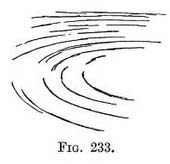
Next Page
Architectural Drawing Prev Page Drawing an Arch
|
||||||||||||||||
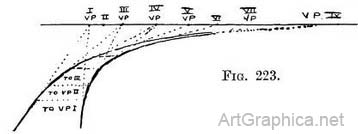 These drawings suggest that a foreshortened curve might in Nature be made up of a number of short straight lengths. If this were so, then in the foreshortened view each length would recede towards a new V.P. We only have to remember our practice with roads inclining up or downhill (see able to correct a faulty drawing by a few lines (as in Fig. 222) drawn freehand. In the same way curves on a horizontal plane, such as a winding river seen from a height, or the track of a road across the valley, might be sketched by short lengths ; each length successively tending to a V.P. further away on the horizon line (Fig. 223).
These drawings suggest that a foreshortened curve might in Nature be made up of a number of short straight lengths. If this were so, then in the foreshortened view each length would recede towards a new V.P. We only have to remember our practice with roads inclining up or downhill (see able to correct a faulty drawing by a few lines (as in Fig. 222) drawn freehand. In the same way curves on a horizontal plane, such as a winding river seen from a height, or the track of a road across the valley, might be sketched by short lengths ; each length successively tending to a V.P. further away on the horizon line (Fig. 223).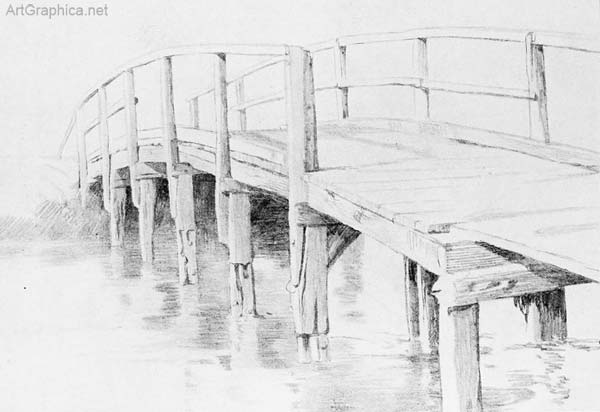
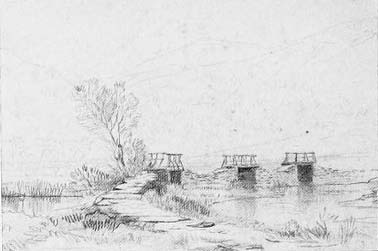
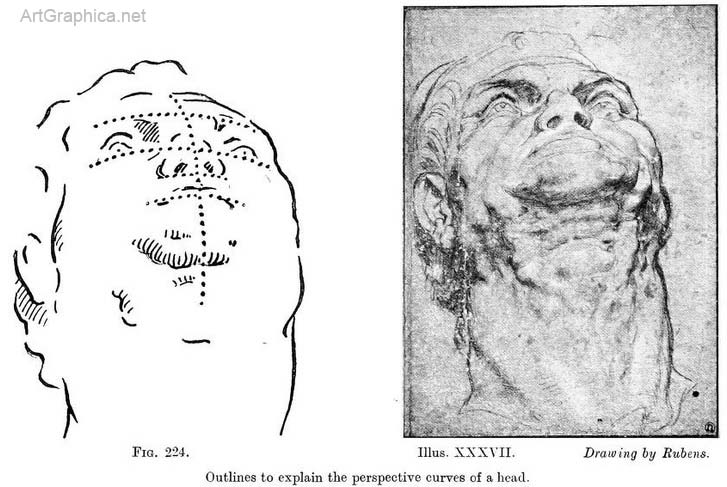 Illus XXXVII. Drawing by Rubens.
Illus XXXVII. Drawing by Rubens.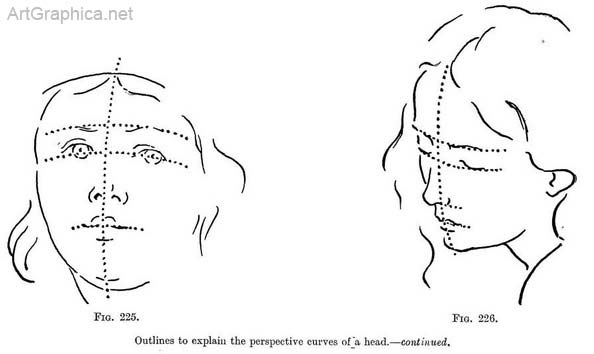
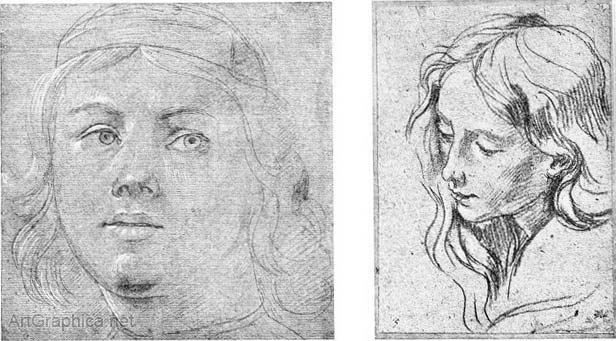
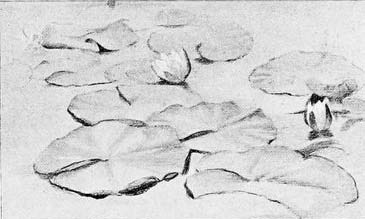

 The river flowing from us gives lovely renderings of the far line (Fig. 231) of a foreshortened circle.
The river flowing from us gives lovely renderings of the far line (Fig. 231) of a foreshortened circle.







